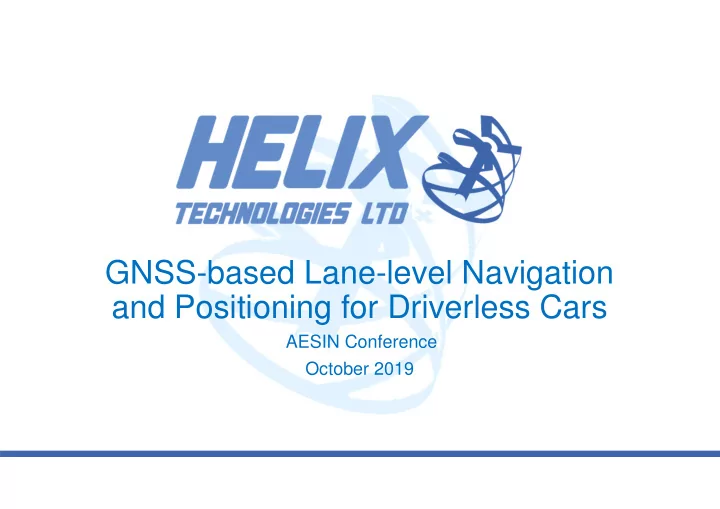

GNSS-based Lane-level Navigation and Positioning for Driverless Cars AESIN Conference October 2019
The Navigation Challenge One of the many challenges faced by designers of driverless vehicles has been how to position and navigate a driverless vehicle with “lane-level” accuracy – which is typically defied as 20 – 30 cm accuracy
Legacy GNSS/GPS Solutions Legacy GNSS/GPS satellite navigation systems have been challenged to provide a compact and cost-effective solution for the navigation and lane-level positioning of driverless cars
Are optical sensors and high resolution mapping the answer? There has been significant investment in the development of lidar and optical sensor-based systems used with high resolution mapping to accurately position an autonomous vehicle in a road or highway
Probably yes for much of the time…. However, in conditions of poor visibility (e.g. heavy rain, snow or fog) or the optical sensors becoming obscured by mud or dust, the operation of the sensors can become significantly degraded
Fog and heavy rain …….. …….can also degrade the performance of the sensors
So can we use satellite navigation technologies as a complement to optical/imaging sensors?
Resilience to atmospheric conditions Satellite navigation systems operate in radio bands that are extremely resilient to atmospheric conditions and will continue to provide high quality and high integrity positioning information in conditions that will challenge the performance of optical-base systems
GPS GNSS Signal Evolution 1995 2005 Today 1575.42 GHz
Next Generation GNSS systems Modern GNSS technologies, including Galileo, BeiDou and GPS III, promise high- precision positioning by using multi-frequency signals that employ advanced waveform modulation schemes, such as Alt-BOC and M-BOC .
Co-ordinated Next Generation GNSS Signals
But how can we benefit from these new constellations and wide-band signals?
Diversity in “urban canyons” • Multi-constellation diversity improves probability of visibility of satellites in urban canyons • Helix antenna has a wider beam width than conventional antenna technologies
Wider antenna beam width = More satellites visible
Multipath signals in urban environments • Reception of multipath signals degrades the accuracy of the GNSS receiver. • Next generation multi-band BOC GNSS signals mitigate against multipath signal reflections • Helix antenna has very high (30dB) multipath rejection
NEXTGEN Multi-frequency GNSS Antenna • Compact antenna based on dielectric-loaded, multi-filar helix technology • Physically 13 mm diameter × 33 mm long • Optimised for Galileo E1/E5, GPS L1/L5 and BeiDou B1//B2 GNSS BOC waveforms • Cross-polarisation isolation of the order of 30dB • Stable phase centre • Operation without a ground plane • Beam-width of the order of 130°
So should GNSS be part of the solution? Multi-constellation diversity • Robust operation in challenging weather conditions • Outstanding positioning performance • Enhanced performance in multipath environments • The Helix antenna used with Next Generation GNSS can significantly enhance the performance and integrity of an autonomous vehicle navigation and positioning system
Helix Technologies believes that the dielectric-loaded, multi-filar helix antenna provides significant performance advantages over incumbent antenna technologies for next-generation GNSS applications
Recommend
More recommend